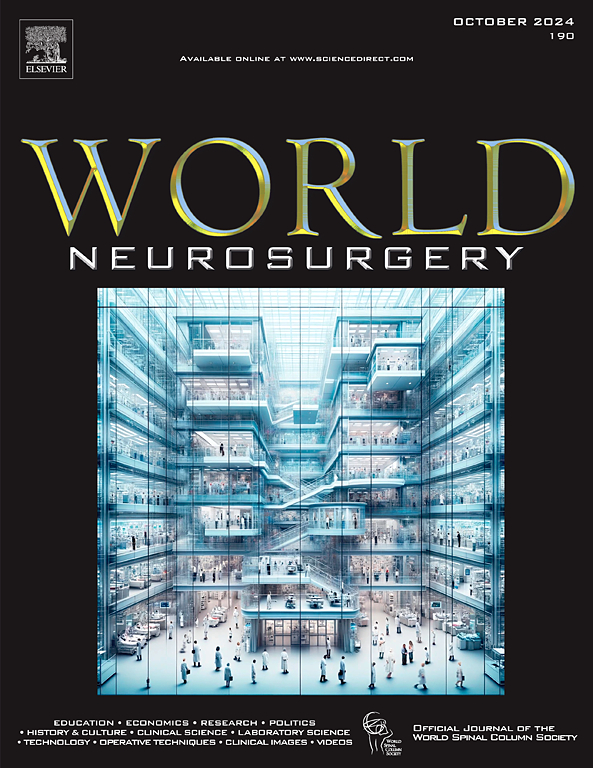Percutaneous Uniportal Endoscopic Decompression Combined with Biportal Endoscopic Lumbar Interbody Fusion versus Minimally Invasive Quadrant Transforaminal Lumbar Interbody Fusion for Single-Level Lumbar Spinal Stenosis
IF 1.9
4区 医学
Q3 CLINICAL NEUROLOGY
引用次数: 0
Abstract
Objective
To compare the clinical outcomes between group A (hybrid endoscopic technique: percutaneous uniportal endoscopic decompression combined with biportal endoscopic lumbar interbody fusion [LIF]) and group B (minimally invasive Quadrant transforaminal LIF) for lumbar spinal stenosis.
Methods
This study included 68 consecutive patients (group A: 32 patients; group B: 36 patients) retrospectively enrolled and treated between June 2019 and June 2021. Perioperative data were prospectively collected, including radiological outcomes (intervertebral disc height, sagittal Cobb angle, lumbar lordosis) and clinical outcomes (Oswestry Disability Index, visual analog scale [VAS], and Short Form 36 Health Survey [SF-36]). Paravertebral muscle injury was assessed by serum creatine phosphokinase levels. Additionally, fusion rate and perioperative complication rates were compared between the two groups.
Results
At 1 month postoperatively, group A demonstrated significantly better outcomes in VAS-Back, VAS-Leg, and SF-36 scores compared to group B (P < 0.05). At 3 months postoperatively, group A demonstrated significantly better outcomes in VAS-Back, Oswestry Disability Index, and SF-36 scores compared to group B (P < 0.05). Creatine phosphokinase levels in group A were significantly lower than those in group B at 1, 3, and 7 days postoperatively (P < 0.05). However, no significant intergroup differences were observed in intervertebral disc height, sagittal Cobb angle, and lumbar lordosis at 1 and 12 months postoperatively (P > 0.1). Additionally, fusion rates and surgical complication rates did not differ significantly between groups (P > 0.05).
Conclusions
The hybrid endoscopic technique (percutaneous uniportal endoscopic decompression combined with biportal endoscopic LIF) demonstrates comparable clinical outcomes and fusion rates to minimally invasive Quadrant transforaminal LIF for lumbar spinal stenosis, while achieving reduced postoperative pain and improved early functional recovery.
单节段腰椎管狭窄的经皮单门静脉内镜减压联合双门静脉内镜腰椎椎间融合术与微创象限经椎间孔腰椎椎间融合术比较。
目的:比较A组(混合内镜技术:经皮单门静脉内镜减压联合双门静脉内镜腰椎体间融合术)和B组(微创象限经椎间孔腰椎体间融合术,MI-TLIF)治疗腰椎管狭窄症(LSS)的临床疗效。方法:本研究纳入68例连续患者(A组:32例;B组:36例患者)在2019年6月至2021年6月期间回顾性入组并接受治疗。前瞻性收集围手术期资料,包括影像学结果(椎间盘高度[IDH]、矢状Cobb角[SCA]、腰椎前凸[LL])和临床结果(Oswestry残疾指数[ODI]、视觉模拟量表[VAS]、短表36健康调查[SF-36])。通过血清肌酸磷酸激酶(CPK)水平评估椎旁肌损伤。比较两组患者的融合率和围手术期并发症发生率。结果:术后1个月,A组VAS-Back、VAS-Leg、SF-36评分均明显优于B组(P < 0.05)。术后3个月,A组VAS-Back、ODI、SF-36评分明显优于B组(P < 0.05)。A组术后1、3、7 d CPK水平显著低于B组(P < 0.05)。然而,术后1个月和12个月IDH、SCA和LL组间差异无统计学意义(P < 0.01)。两组间融合率及手术并发症发生率差异无统计学意义(P < 0.05)。结论:混合内镜技术(经皮单门静脉内镜减压联合双门静脉内镜腰椎体间融合术)的临床效果和融合率与微创象限经椎间孔腰椎体间融合术(MI-TLIF)相当,同时减少了术后疼痛并改善了早期功能恢复。
本文章由计算机程序翻译,如有差异,请以英文原文为准。
求助全文
约1分钟内获得全文
求助全文
来源期刊

World neurosurgery
CLINICAL NEUROLOGY-SURGERY
CiteScore
3.90
自引率
15.00%
发文量
1765
审稿时长
47 days
期刊介绍:
World Neurosurgery has an open access mirror journal World Neurosurgery: X, sharing the same aims and scope, editorial team, submission system and rigorous peer review.
The journal''s mission is to:
-To provide a first-class international forum and a 2-way conduit for dialogue that is relevant to neurosurgeons and providers who care for neurosurgery patients. The categories of the exchanged information include clinical and basic science, as well as global information that provide social, political, educational, economic, cultural or societal insights and knowledge that are of significance and relevance to worldwide neurosurgery patient care.
-To act as a primary intellectual catalyst for the stimulation of creativity, the creation of new knowledge, and the enhancement of quality neurosurgical care worldwide.
-To provide a forum for communication that enriches the lives of all neurosurgeons and their colleagues; and, in so doing, enriches the lives of their patients.
Topics to be addressed in World Neurosurgery include: EDUCATION, ECONOMICS, RESEARCH, POLITICS, HISTORY, CULTURE, CLINICAL SCIENCE, LABORATORY SCIENCE, TECHNOLOGY, OPERATIVE TECHNIQUES, CLINICAL IMAGES, VIDEOS
 求助内容:
求助内容: 应助结果提醒方式:
应助结果提醒方式:


